Corporate Governance and CSR: Enhancing Shareholder Value Report
VerifiedAdded on 2023/05/30
|18
|4627
|432
Report
AI Summary
This report provides a comprehensive overview of corporate governance and its impact on stakeholder relationships and shareholder value. It defines corporate governance and corporate social responsibility (CSR), highlighting their importance in managing organizations effectively. The report delves into key theories of corporate governance, including agency, stewardship, resource-dependence, and stakeholder theories, providing a framework for understanding different perspectives. It then explores the meaning, principles, and various purposes of CSR, emphasizing its role in ethical business practices and long-term profitability. A critical analysis of the National Association of Pension Funds' guidance on corporate governance is included. The report concludes by summarizing the significance of corporate governance and CSR in fostering positive relationships with stakeholders, ensuring legal compliance, and enhancing the overall well-being of the organization. The report emphasizes the importance of ethical business practices and strategic alignment for achieving sustainable success.
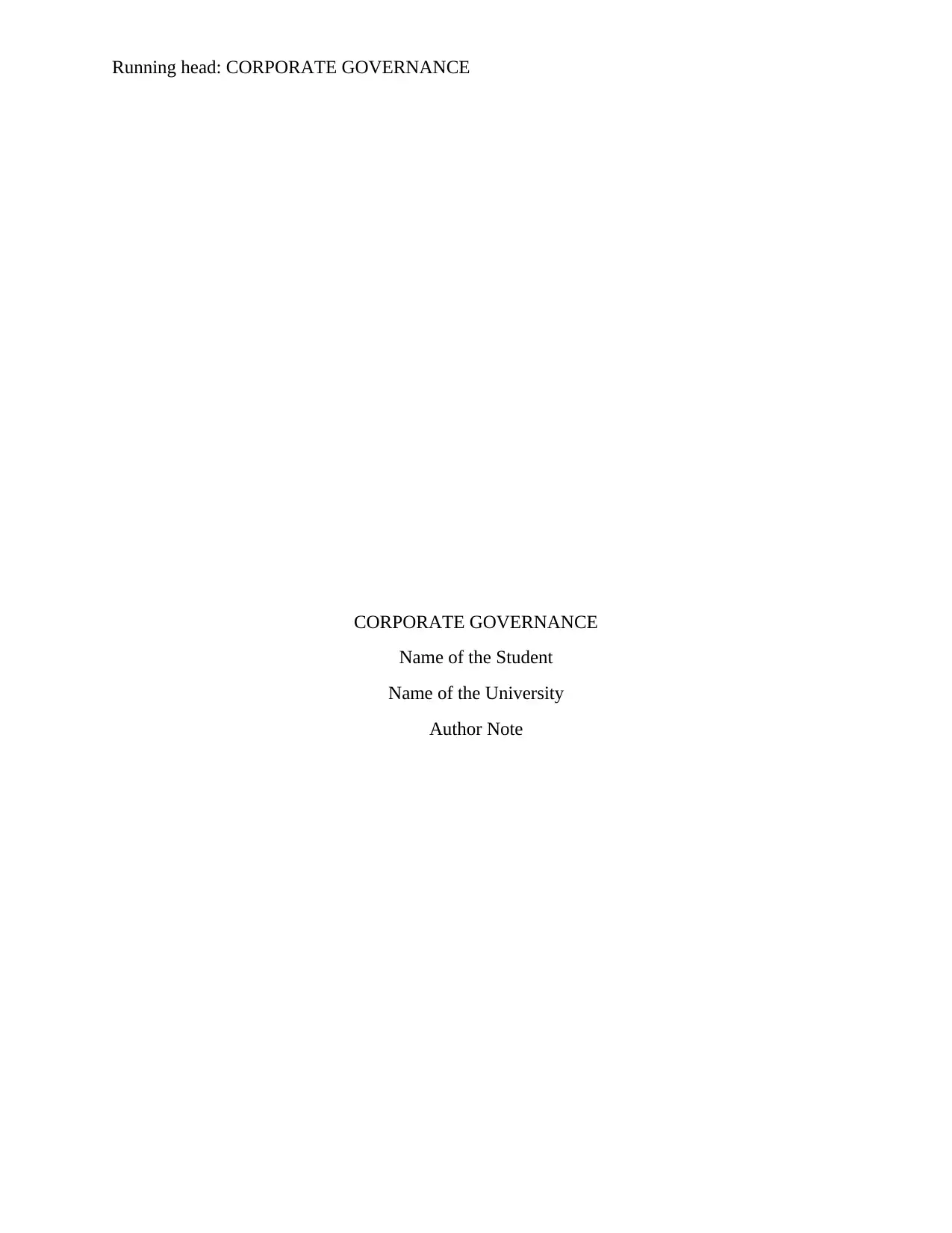
Running head: CORPORATE GOVERNANCE
CORPORATE GOVERNANCE
Name of the Student
Name of the University
Author Note
CORPORATE GOVERNANCE
Name of the Student
Name of the University
Author Note
Paraphrase This Document
Need a fresh take? Get an instant paraphrase of this document with our AI Paraphraser
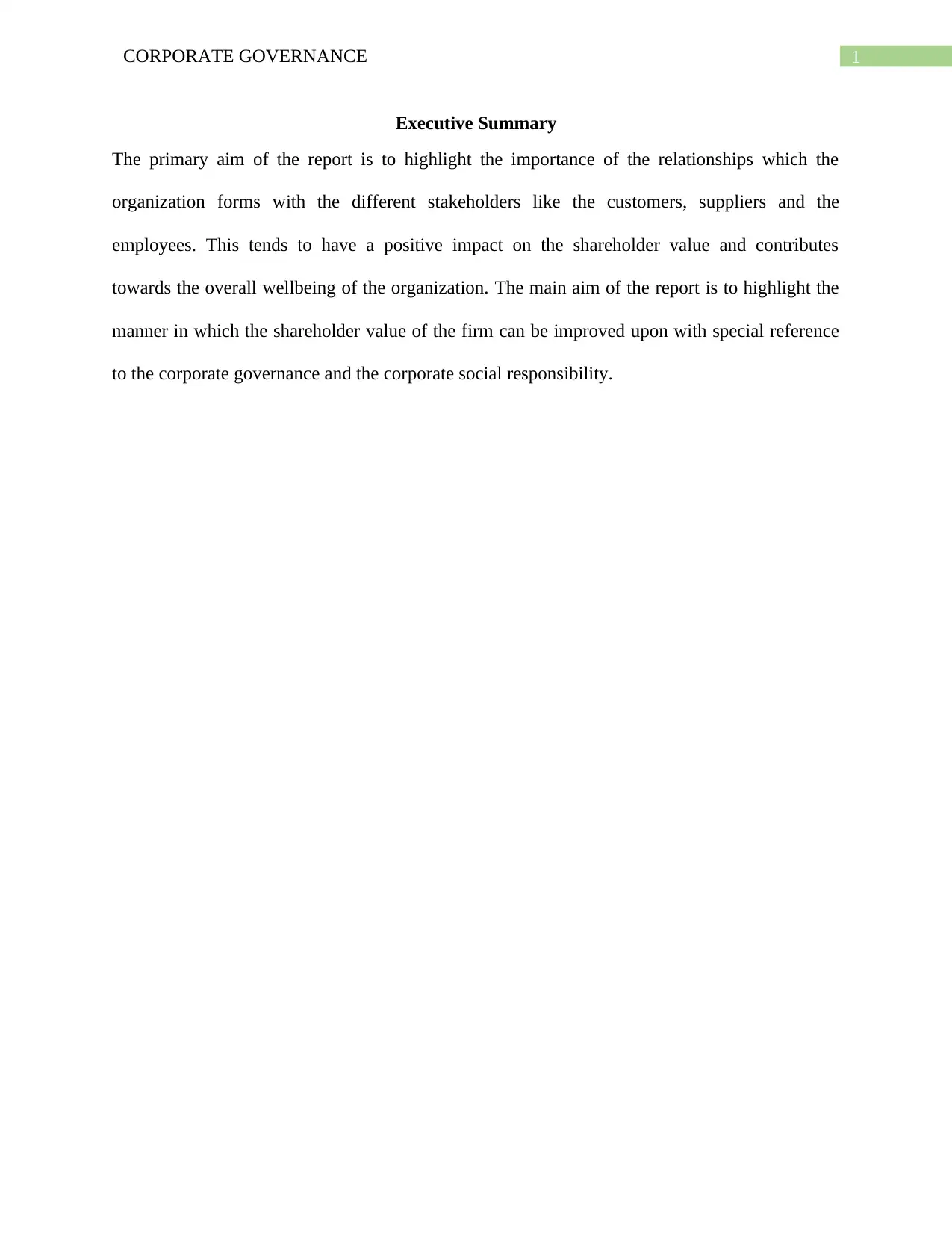
1CORPORATE GOVERNANCE
Executive Summary
The primary aim of the report is to highlight the importance of the relationships which the
organization forms with the different stakeholders like the customers, suppliers and the
employees. This tends to have a positive impact on the shareholder value and contributes
towards the overall wellbeing of the organization. The main aim of the report is to highlight the
manner in which the shareholder value of the firm can be improved upon with special reference
to the corporate governance and the corporate social responsibility.
Executive Summary
The primary aim of the report is to highlight the importance of the relationships which the
organization forms with the different stakeholders like the customers, suppliers and the
employees. This tends to have a positive impact on the shareholder value and contributes
towards the overall wellbeing of the organization. The main aim of the report is to highlight the
manner in which the shareholder value of the firm can be improved upon with special reference
to the corporate governance and the corporate social responsibility.
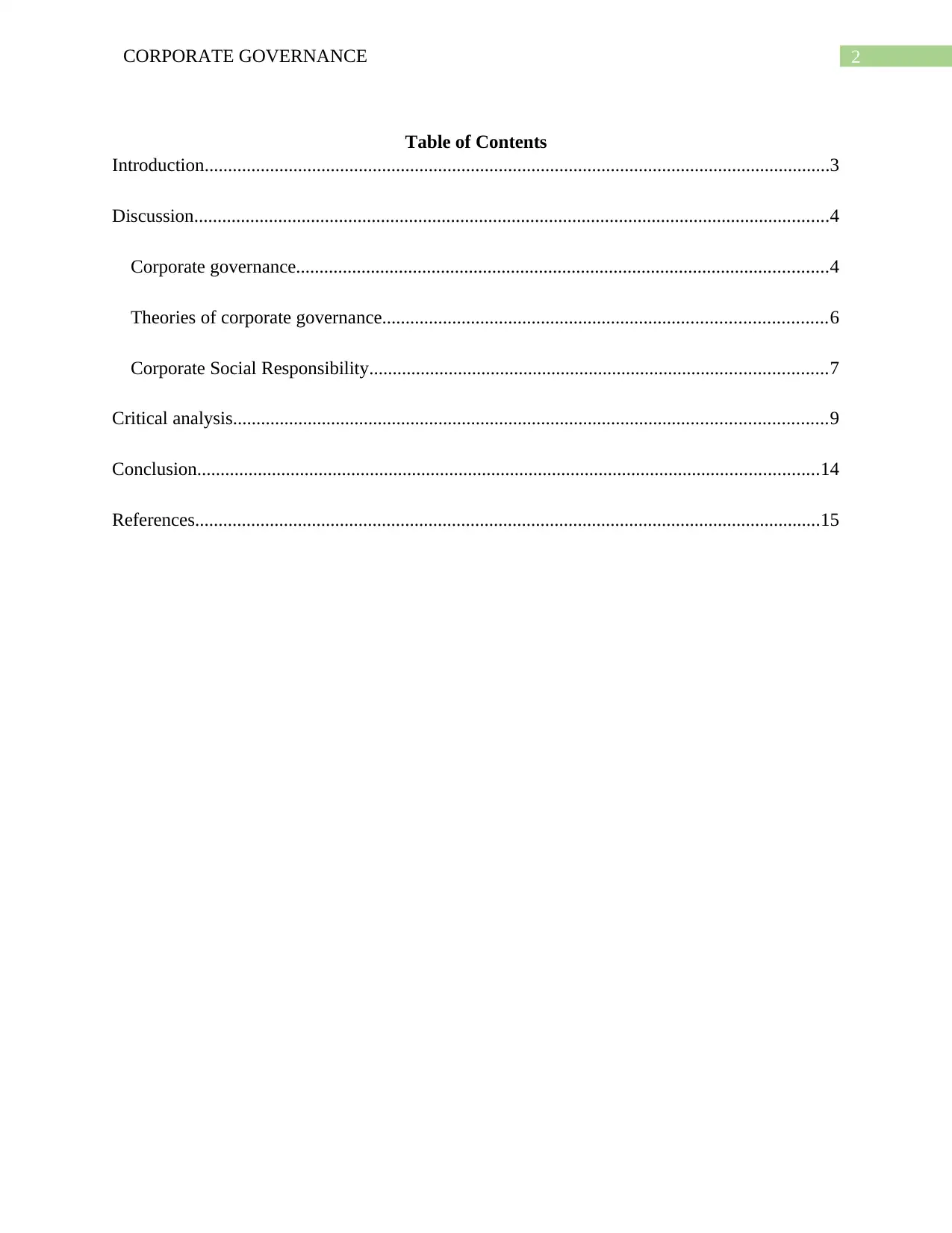
2CORPORATE GOVERNANCE
Table of Contents
Introduction......................................................................................................................................3
Discussion........................................................................................................................................4
Corporate governance..................................................................................................................4
Theories of corporate governance...............................................................................................6
Corporate Social Responsibility..................................................................................................7
Critical analysis...............................................................................................................................9
Conclusion.....................................................................................................................................14
References......................................................................................................................................15
Table of Contents
Introduction......................................................................................................................................3
Discussion........................................................................................................................................4
Corporate governance..................................................................................................................4
Theories of corporate governance...............................................................................................6
Corporate Social Responsibility..................................................................................................7
Critical analysis...............................................................................................................................9
Conclusion.....................................................................................................................................14
References......................................................................................................................................15
⊘ This is a preview!⊘
Do you want full access?
Subscribe today to unlock all pages.

Trusted by 1+ million students worldwide
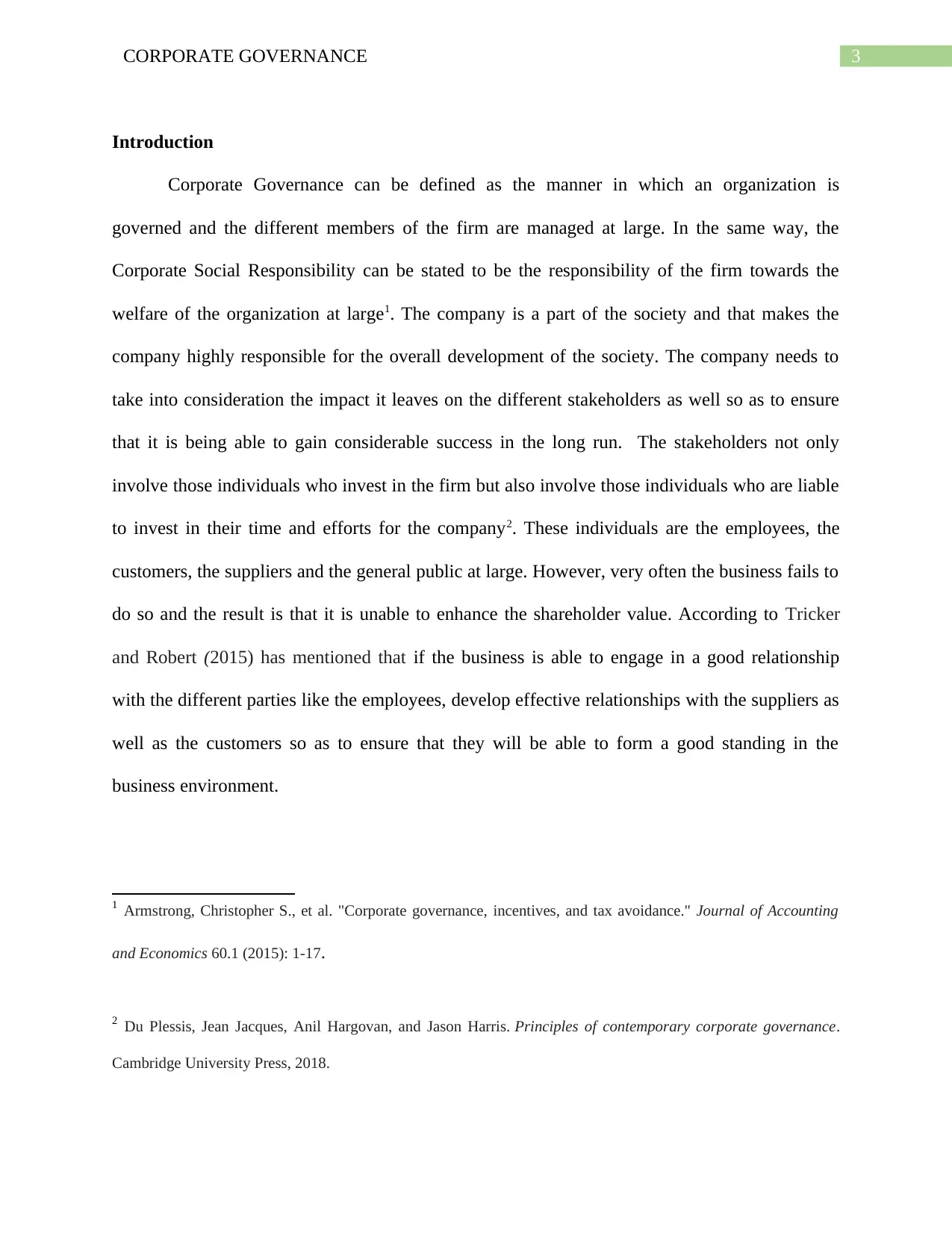
3CORPORATE GOVERNANCE
Introduction
Corporate Governance can be defined as the manner in which an organization is
governed and the different members of the firm are managed at large. In the same way, the
Corporate Social Responsibility can be stated to be the responsibility of the firm towards the
welfare of the organization at large1. The company is a part of the society and that makes the
company highly responsible for the overall development of the society. The company needs to
take into consideration the impact it leaves on the different stakeholders as well so as to ensure
that it is being able to gain considerable success in the long run. The stakeholders not only
involve those individuals who invest in the firm but also involve those individuals who are liable
to invest in their time and efforts for the company2. These individuals are the employees, the
customers, the suppliers and the general public at large. However, very often the business fails to
do so and the result is that it is unable to enhance the shareholder value. According to Tricker
and Robert (2015) has mentioned that if the business is able to engage in a good relationship
with the different parties like the employees, develop effective relationships with the suppliers as
well as the customers so as to ensure that they will be able to form a good standing in the
business environment.
1 Armstrong, Christopher S., et al. "Corporate governance, incentives, and tax avoidance." Journal of Accounting
and Economics 60.1 (2015): 1-17.
2 Du Plessis, Jean Jacques, Anil Hargovan, and Jason Harris. Principles of contemporary corporate governance.
Cambridge University Press, 2018.
Introduction
Corporate Governance can be defined as the manner in which an organization is
governed and the different members of the firm are managed at large. In the same way, the
Corporate Social Responsibility can be stated to be the responsibility of the firm towards the
welfare of the organization at large1. The company is a part of the society and that makes the
company highly responsible for the overall development of the society. The company needs to
take into consideration the impact it leaves on the different stakeholders as well so as to ensure
that it is being able to gain considerable success in the long run. The stakeholders not only
involve those individuals who invest in the firm but also involve those individuals who are liable
to invest in their time and efforts for the company2. These individuals are the employees, the
customers, the suppliers and the general public at large. However, very often the business fails to
do so and the result is that it is unable to enhance the shareholder value. According to Tricker
and Robert (2015) has mentioned that if the business is able to engage in a good relationship
with the different parties like the employees, develop effective relationships with the suppliers as
well as the customers so as to ensure that they will be able to form a good standing in the
business environment.
1 Armstrong, Christopher S., et al. "Corporate governance, incentives, and tax avoidance." Journal of Accounting
and Economics 60.1 (2015): 1-17.
2 Du Plessis, Jean Jacques, Anil Hargovan, and Jason Harris. Principles of contemporary corporate governance.
Cambridge University Press, 2018.
Paraphrase This Document
Need a fresh take? Get an instant paraphrase of this document with our AI Paraphraser
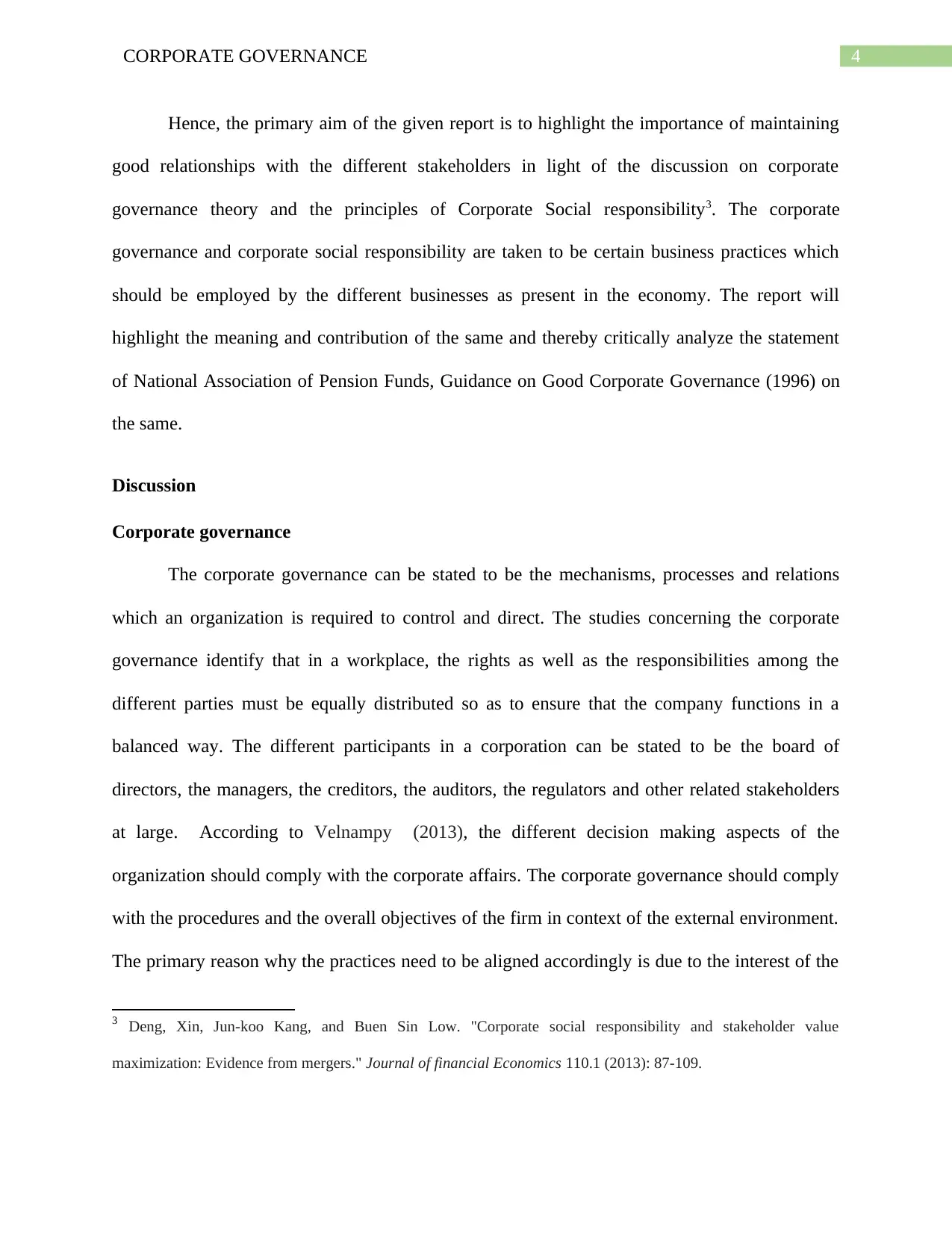
4CORPORATE GOVERNANCE
Hence, the primary aim of the given report is to highlight the importance of maintaining
good relationships with the different stakeholders in light of the discussion on corporate
governance theory and the principles of Corporate Social responsibility3. The corporate
governance and corporate social responsibility are taken to be certain business practices which
should be employed by the different businesses as present in the economy. The report will
highlight the meaning and contribution of the same and thereby critically analyze the statement
of National Association of Pension Funds, Guidance on Good Corporate Governance (1996) on
the same.
Discussion
Corporate governance
The corporate governance can be stated to be the mechanisms, processes and relations
which an organization is required to control and direct. The studies concerning the corporate
governance identify that in a workplace, the rights as well as the responsibilities among the
different parties must be equally distributed so as to ensure that the company functions in a
balanced way. The different participants in a corporation can be stated to be the board of
directors, the managers, the creditors, the auditors, the regulators and other related stakeholders
at large. According to Velnampy (2013), the different decision making aspects of the
organization should comply with the corporate affairs. The corporate governance should comply
with the procedures and the overall objectives of the firm in context of the external environment.
The primary reason why the practices need to be aligned accordingly is due to the interest of the
3 Deng, Xin, Jun-koo Kang, and Buen Sin Low. "Corporate social responsibility and stakeholder value
maximization: Evidence from mergers." Journal of financial Economics 110.1 (2013): 87-109.
Hence, the primary aim of the given report is to highlight the importance of maintaining
good relationships with the different stakeholders in light of the discussion on corporate
governance theory and the principles of Corporate Social responsibility3. The corporate
governance and corporate social responsibility are taken to be certain business practices which
should be employed by the different businesses as present in the economy. The report will
highlight the meaning and contribution of the same and thereby critically analyze the statement
of National Association of Pension Funds, Guidance on Good Corporate Governance (1996) on
the same.
Discussion
Corporate governance
The corporate governance can be stated to be the mechanisms, processes and relations
which an organization is required to control and direct. The studies concerning the corporate
governance identify that in a workplace, the rights as well as the responsibilities among the
different parties must be equally distributed so as to ensure that the company functions in a
balanced way. The different participants in a corporation can be stated to be the board of
directors, the managers, the creditors, the auditors, the regulators and other related stakeholders
at large. According to Velnampy (2013), the different decision making aspects of the
organization should comply with the corporate affairs. The corporate governance should comply
with the procedures and the overall objectives of the firm in context of the external environment.
The primary reason why the practices need to be aligned accordingly is due to the interest of the
3 Deng, Xin, Jun-koo Kang, and Buen Sin Low. "Corporate social responsibility and stakeholder value
maximization: Evidence from mergers." Journal of financial Economics 110.1 (2013): 87-109.
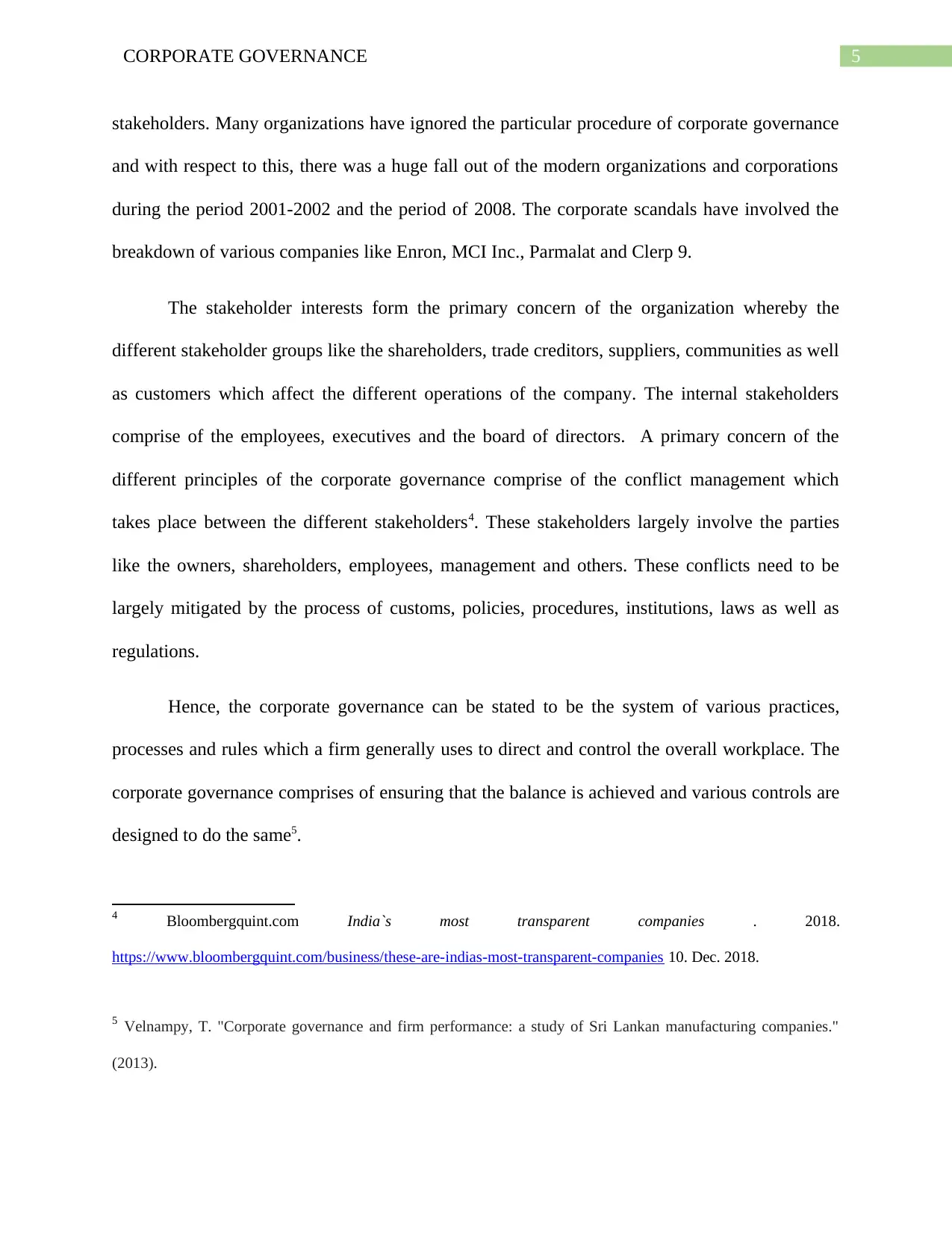
5CORPORATE GOVERNANCE
stakeholders. Many organizations have ignored the particular procedure of corporate governance
and with respect to this, there was a huge fall out of the modern organizations and corporations
during the period 2001-2002 and the period of 2008. The corporate scandals have involved the
breakdown of various companies like Enron, MCI Inc., Parmalat and Clerp 9.
The stakeholder interests form the primary concern of the organization whereby the
different stakeholder groups like the shareholders, trade creditors, suppliers, communities as well
as customers which affect the different operations of the company. The internal stakeholders
comprise of the employees, executives and the board of directors. A primary concern of the
different principles of the corporate governance comprise of the conflict management which
takes place between the different stakeholders4. These stakeholders largely involve the parties
like the owners, shareholders, employees, management and others. These conflicts need to be
largely mitigated by the process of customs, policies, procedures, institutions, laws as well as
regulations.
Hence, the corporate governance can be stated to be the system of various practices,
processes and rules which a firm generally uses to direct and control the overall workplace. The
corporate governance comprises of ensuring that the balance is achieved and various controls are
designed to do the same5.
4 Bloombergquint.com India`s most transparent companies . 2018.
https://www.bloombergquint.com/business/these-are-indias-most-transparent-companies 10. Dec. 2018.
5 Velnampy, T. "Corporate governance and firm performance: a study of Sri Lankan manufacturing companies."
(2013).
stakeholders. Many organizations have ignored the particular procedure of corporate governance
and with respect to this, there was a huge fall out of the modern organizations and corporations
during the period 2001-2002 and the period of 2008. The corporate scandals have involved the
breakdown of various companies like Enron, MCI Inc., Parmalat and Clerp 9.
The stakeholder interests form the primary concern of the organization whereby the
different stakeholder groups like the shareholders, trade creditors, suppliers, communities as well
as customers which affect the different operations of the company. The internal stakeholders
comprise of the employees, executives and the board of directors. A primary concern of the
different principles of the corporate governance comprise of the conflict management which
takes place between the different stakeholders4. These stakeholders largely involve the parties
like the owners, shareholders, employees, management and others. These conflicts need to be
largely mitigated by the process of customs, policies, procedures, institutions, laws as well as
regulations.
Hence, the corporate governance can be stated to be the system of various practices,
processes and rules which a firm generally uses to direct and control the overall workplace. The
corporate governance comprises of ensuring that the balance is achieved and various controls are
designed to do the same5.
4 Bloombergquint.com India`s most transparent companies . 2018.
https://www.bloombergquint.com/business/these-are-indias-most-transparent-companies 10. Dec. 2018.
5 Velnampy, T. "Corporate governance and firm performance: a study of Sri Lankan manufacturing companies."
(2013).
⊘ This is a preview!⊘
Do you want full access?
Subscribe today to unlock all pages.

Trusted by 1+ million students worldwide
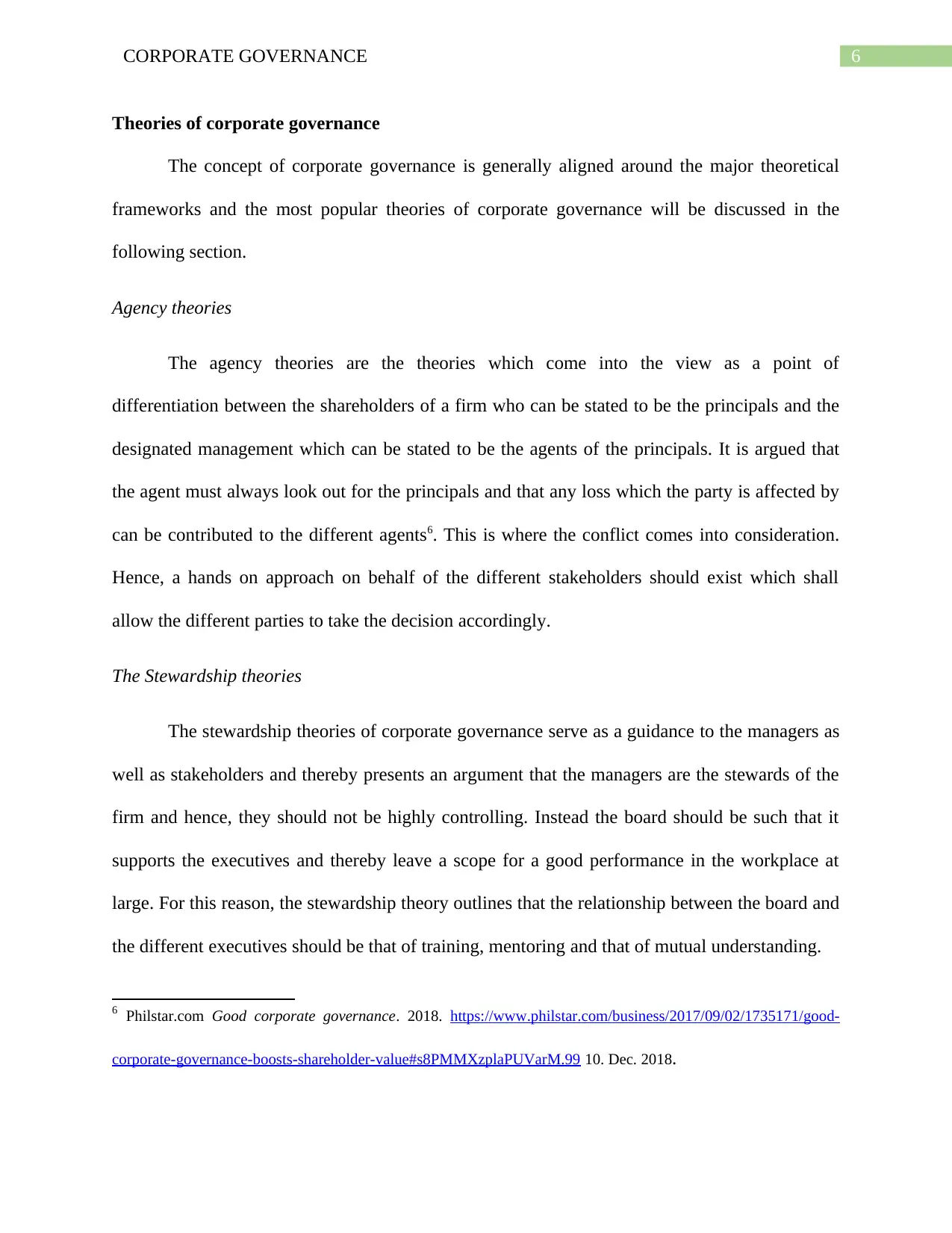
6CORPORATE GOVERNANCE
Theories of corporate governance
The concept of corporate governance is generally aligned around the major theoretical
frameworks and the most popular theories of corporate governance will be discussed in the
following section.
Agency theories
The agency theories are the theories which come into the view as a point of
differentiation between the shareholders of a firm who can be stated to be the principals and the
designated management which can be stated to be the agents of the principals. It is argued that
the agent must always look out for the principals and that any loss which the party is affected by
can be contributed to the different agents6. This is where the conflict comes into consideration.
Hence, a hands on approach on behalf of the different stakeholders should exist which shall
allow the different parties to take the decision accordingly.
The Stewardship theories
The stewardship theories of corporate governance serve as a guidance to the managers as
well as stakeholders and thereby presents an argument that the managers are the stewards of the
firm and hence, they should not be highly controlling. Instead the board should be such that it
supports the executives and thereby leave a scope for a good performance in the workplace at
large. For this reason, the stewardship theory outlines that the relationship between the board and
the different executives should be that of training, mentoring and that of mutual understanding.
6 Philstar.com Good corporate governance. 2018. https://www.philstar.com/business/2017/09/02/1735171/good-
corporate-governance-boosts-shareholder-value#s8PMMXzplaPUVarM.99 10. Dec. 2018.
Theories of corporate governance
The concept of corporate governance is generally aligned around the major theoretical
frameworks and the most popular theories of corporate governance will be discussed in the
following section.
Agency theories
The agency theories are the theories which come into the view as a point of
differentiation between the shareholders of a firm who can be stated to be the principals and the
designated management which can be stated to be the agents of the principals. It is argued that
the agent must always look out for the principals and that any loss which the party is affected by
can be contributed to the different agents6. This is where the conflict comes into consideration.
Hence, a hands on approach on behalf of the different stakeholders should exist which shall
allow the different parties to take the decision accordingly.
The Stewardship theories
The stewardship theories of corporate governance serve as a guidance to the managers as
well as stakeholders and thereby presents an argument that the managers are the stewards of the
firm and hence, they should not be highly controlling. Instead the board should be such that it
supports the executives and thereby leave a scope for a good performance in the workplace at
large. For this reason, the stewardship theory outlines that the relationship between the board and
the different executives should be that of training, mentoring and that of mutual understanding.
6 Philstar.com Good corporate governance. 2018. https://www.philstar.com/business/2017/09/02/1735171/good-
corporate-governance-boosts-shareholder-value#s8PMMXzplaPUVarM.99 10. Dec. 2018.
Paraphrase This Document
Need a fresh take? Get an instant paraphrase of this document with our AI Paraphraser
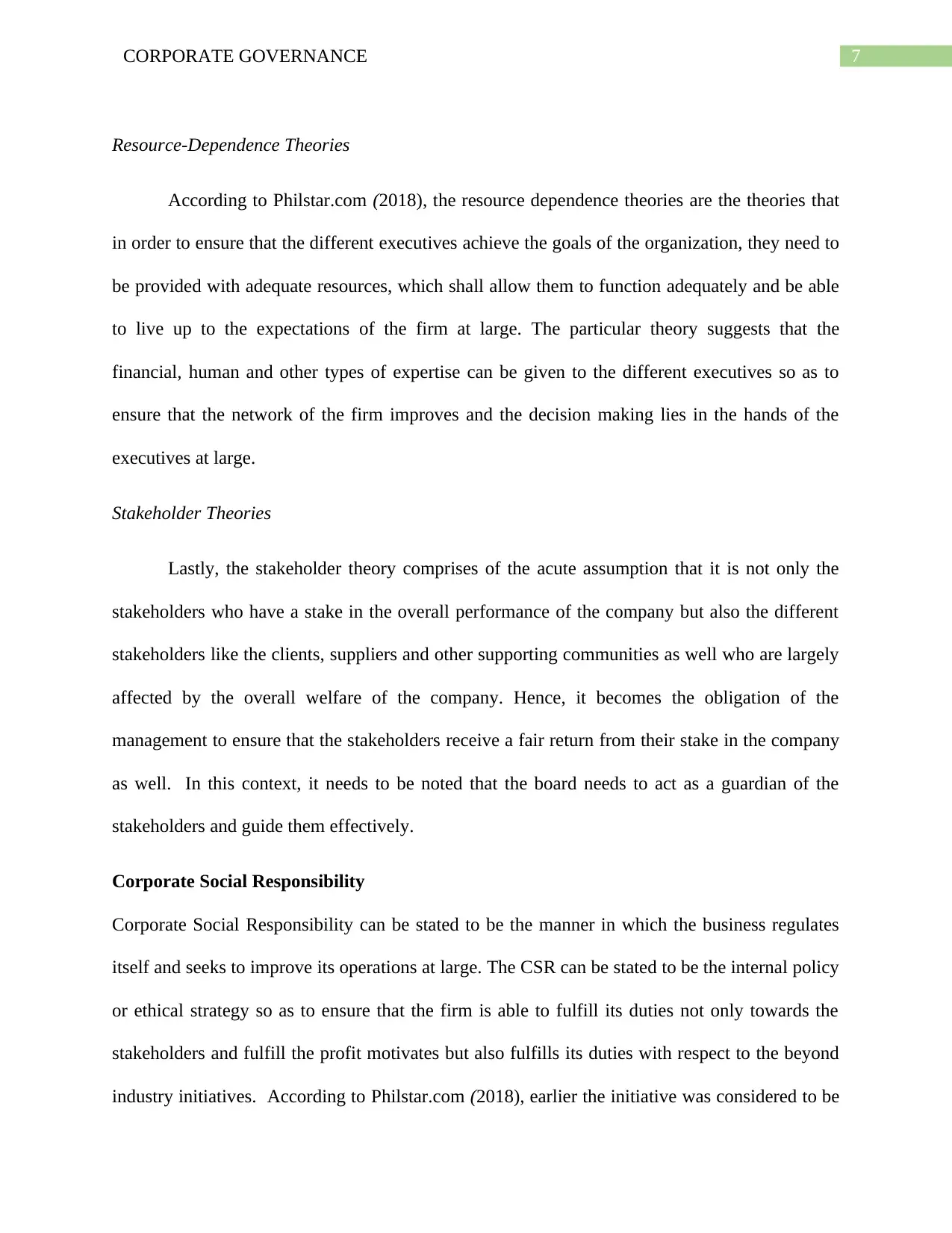
7CORPORATE GOVERNANCE
Resource-Dependence Theories
According to Philstar.com (2018), the resource dependence theories are the theories that
in order to ensure that the different executives achieve the goals of the organization, they need to
be provided with adequate resources, which shall allow them to function adequately and be able
to live up to the expectations of the firm at large. The particular theory suggests that the
financial, human and other types of expertise can be given to the different executives so as to
ensure that the network of the firm improves and the decision making lies in the hands of the
executives at large.
Stakeholder Theories
Lastly, the stakeholder theory comprises of the acute assumption that it is not only the
stakeholders who have a stake in the overall performance of the company but also the different
stakeholders like the clients, suppliers and other supporting communities as well who are largely
affected by the overall welfare of the company. Hence, it becomes the obligation of the
management to ensure that the stakeholders receive a fair return from their stake in the company
as well. In this context, it needs to be noted that the board needs to act as a guardian of the
stakeholders and guide them effectively.
Corporate Social Responsibility
Corporate Social Responsibility can be stated to be the manner in which the business regulates
itself and seeks to improve its operations at large. The CSR can be stated to be the internal policy
or ethical strategy so as to ensure that the firm is able to fulfill its duties not only towards the
stakeholders and fulfill the profit motivates but also fulfills its duties with respect to the beyond
industry initiatives. According to Philstar.com (2018), earlier the initiative was considered to be
Resource-Dependence Theories
According to Philstar.com (2018), the resource dependence theories are the theories that
in order to ensure that the different executives achieve the goals of the organization, they need to
be provided with adequate resources, which shall allow them to function adequately and be able
to live up to the expectations of the firm at large. The particular theory suggests that the
financial, human and other types of expertise can be given to the different executives so as to
ensure that the network of the firm improves and the decision making lies in the hands of the
executives at large.
Stakeholder Theories
Lastly, the stakeholder theory comprises of the acute assumption that it is not only the
stakeholders who have a stake in the overall performance of the company but also the different
stakeholders like the clients, suppliers and other supporting communities as well who are largely
affected by the overall welfare of the company. Hence, it becomes the obligation of the
management to ensure that the stakeholders receive a fair return from their stake in the company
as well. In this context, it needs to be noted that the board needs to act as a guardian of the
stakeholders and guide them effectively.
Corporate Social Responsibility
Corporate Social Responsibility can be stated to be the manner in which the business regulates
itself and seeks to improve its operations at large. The CSR can be stated to be the internal policy
or ethical strategy so as to ensure that the firm is able to fulfill its duties not only towards the
stakeholders and fulfill the profit motivates but also fulfills its duties with respect to the beyond
industry initiatives. According to Philstar.com (2018), earlier the initiative was considered to be
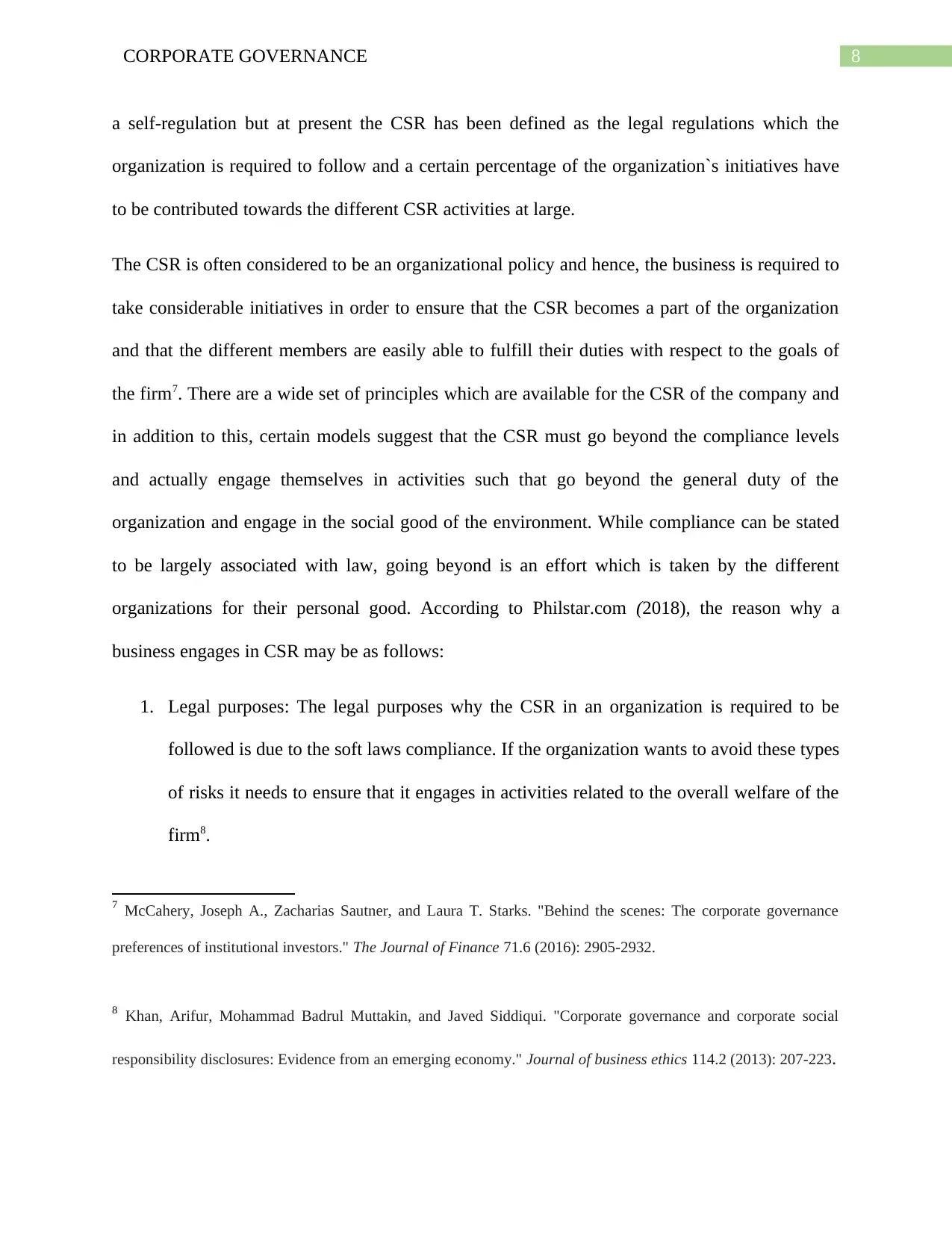
8CORPORATE GOVERNANCE
a self-regulation but at present the CSR has been defined as the legal regulations which the
organization is required to follow and a certain percentage of the organization`s initiatives have
to be contributed towards the different CSR activities at large.
The CSR is often considered to be an organizational policy and hence, the business is required to
take considerable initiatives in order to ensure that the CSR becomes a part of the organization
and that the different members are easily able to fulfill their duties with respect to the goals of
the firm7. There are a wide set of principles which are available for the CSR of the company and
in addition to this, certain models suggest that the CSR must go beyond the compliance levels
and actually engage themselves in activities such that go beyond the general duty of the
organization and engage in the social good of the environment. While compliance can be stated
to be largely associated with law, going beyond is an effort which is taken by the different
organizations for their personal good. According to Philstar.com (2018), the reason why a
business engages in CSR may be as follows:
1. Legal purposes: The legal purposes why the CSR in an organization is required to be
followed is due to the soft laws compliance. If the organization wants to avoid these types
of risks it needs to ensure that it engages in activities related to the overall welfare of the
firm8.
7 McCahery, Joseph A., Zacharias Sautner, and Laura T. Starks. "Behind the scenes: The corporate governance
preferences of institutional investors." The Journal of Finance 71.6 (2016): 2905-2932.
8 Khan, Arifur, Mohammad Badrul Muttakin, and Javed Siddiqui. "Corporate governance and corporate social
responsibility disclosures: Evidence from an emerging economy." Journal of business ethics 114.2 (2013): 207-223.
a self-regulation but at present the CSR has been defined as the legal regulations which the
organization is required to follow and a certain percentage of the organization`s initiatives have
to be contributed towards the different CSR activities at large.
The CSR is often considered to be an organizational policy and hence, the business is required to
take considerable initiatives in order to ensure that the CSR becomes a part of the organization
and that the different members are easily able to fulfill their duties with respect to the goals of
the firm7. There are a wide set of principles which are available for the CSR of the company and
in addition to this, certain models suggest that the CSR must go beyond the compliance levels
and actually engage themselves in activities such that go beyond the general duty of the
organization and engage in the social good of the environment. While compliance can be stated
to be largely associated with law, going beyond is an effort which is taken by the different
organizations for their personal good. According to Philstar.com (2018), the reason why a
business engages in CSR may be as follows:
1. Legal purposes: The legal purposes why the CSR in an organization is required to be
followed is due to the soft laws compliance. If the organization wants to avoid these types
of risks it needs to ensure that it engages in activities related to the overall welfare of the
firm8.
7 McCahery, Joseph A., Zacharias Sautner, and Laura T. Starks. "Behind the scenes: The corporate governance
preferences of institutional investors." The Journal of Finance 71.6 (2016): 2905-2932.
8 Khan, Arifur, Mohammad Badrul Muttakin, and Javed Siddiqui. "Corporate governance and corporate social
responsibility disclosures: Evidence from an emerging economy." Journal of business ethics 114.2 (2013): 207-223.
⊘ This is a preview!⊘
Do you want full access?
Subscribe today to unlock all pages.

Trusted by 1+ million students worldwide
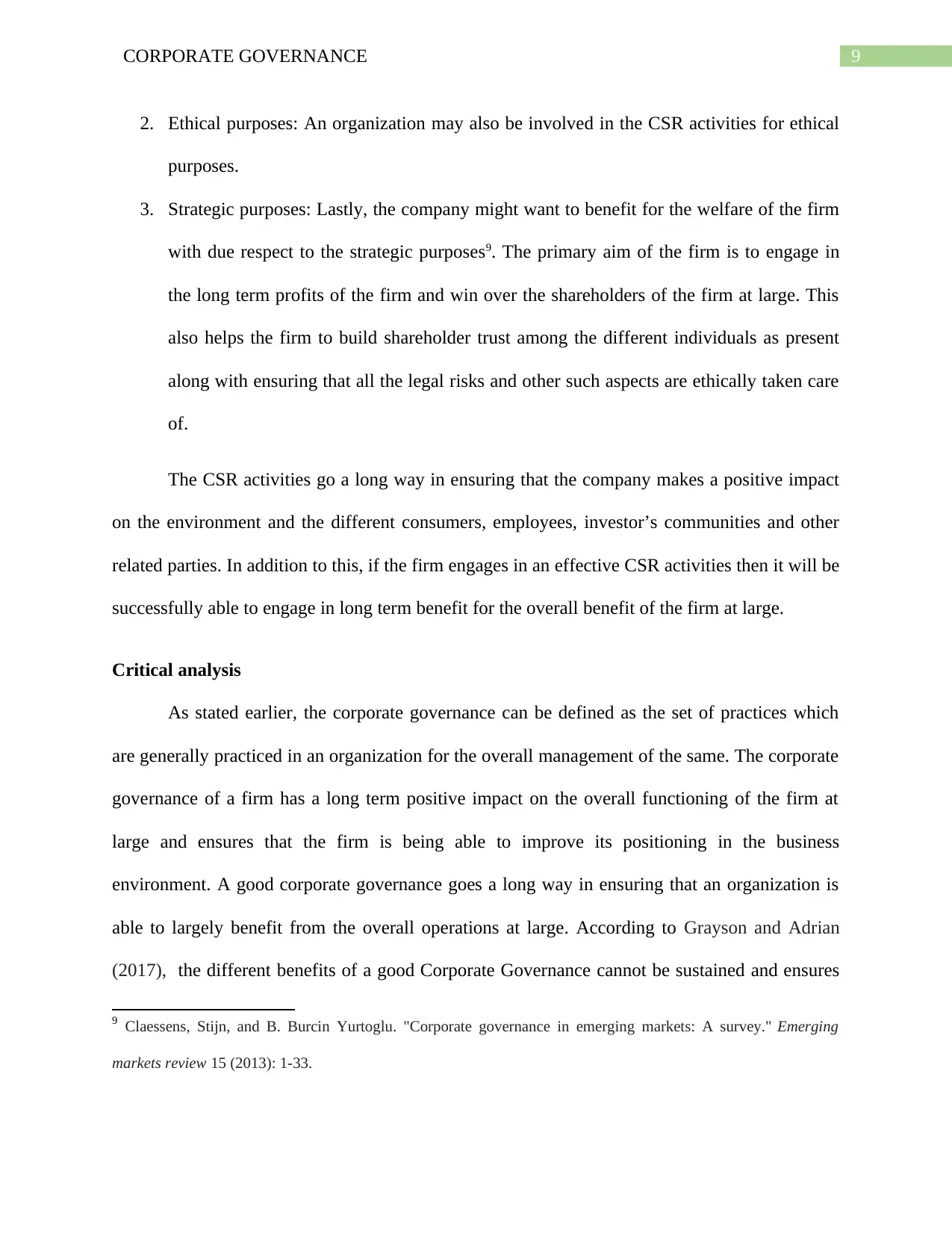
9CORPORATE GOVERNANCE
2. Ethical purposes: An organization may also be involved in the CSR activities for ethical
purposes.
3. Strategic purposes: Lastly, the company might want to benefit for the welfare of the firm
with due respect to the strategic purposes9. The primary aim of the firm is to engage in
the long term profits of the firm and win over the shareholders of the firm at large. This
also helps the firm to build shareholder trust among the different individuals as present
along with ensuring that all the legal risks and other such aspects are ethically taken care
of.
The CSR activities go a long way in ensuring that the company makes a positive impact
on the environment and the different consumers, employees, investor’s communities and other
related parties. In addition to this, if the firm engages in an effective CSR activities then it will be
successfully able to engage in long term benefit for the overall benefit of the firm at large.
Critical analysis
As stated earlier, the corporate governance can be defined as the set of practices which
are generally practiced in an organization for the overall management of the same. The corporate
governance of a firm has a long term positive impact on the overall functioning of the firm at
large and ensures that the firm is being able to improve its positioning in the business
environment. A good corporate governance goes a long way in ensuring that an organization is
able to largely benefit from the overall operations at large. According to Grayson and Adrian
(2017), the different benefits of a good Corporate Governance cannot be sustained and ensures
9 Claessens, Stijn, and B. Burcin Yurtoglu. "Corporate governance in emerging markets: A survey." Emerging
markets review 15 (2013): 1-33.
2. Ethical purposes: An organization may also be involved in the CSR activities for ethical
purposes.
3. Strategic purposes: Lastly, the company might want to benefit for the welfare of the firm
with due respect to the strategic purposes9. The primary aim of the firm is to engage in
the long term profits of the firm and win over the shareholders of the firm at large. This
also helps the firm to build shareholder trust among the different individuals as present
along with ensuring that all the legal risks and other such aspects are ethically taken care
of.
The CSR activities go a long way in ensuring that the company makes a positive impact
on the environment and the different consumers, employees, investor’s communities and other
related parties. In addition to this, if the firm engages in an effective CSR activities then it will be
successfully able to engage in long term benefit for the overall benefit of the firm at large.
Critical analysis
As stated earlier, the corporate governance can be defined as the set of practices which
are generally practiced in an organization for the overall management of the same. The corporate
governance of a firm has a long term positive impact on the overall functioning of the firm at
large and ensures that the firm is being able to improve its positioning in the business
environment. A good corporate governance goes a long way in ensuring that an organization is
able to largely benefit from the overall operations at large. According to Grayson and Adrian
(2017), the different benefits of a good Corporate Governance cannot be sustained and ensures
9 Claessens, Stijn, and B. Burcin Yurtoglu. "Corporate governance in emerging markets: A survey." Emerging
markets review 15 (2013): 1-33.
Paraphrase This Document
Need a fresh take? Get an instant paraphrase of this document with our AI Paraphraser
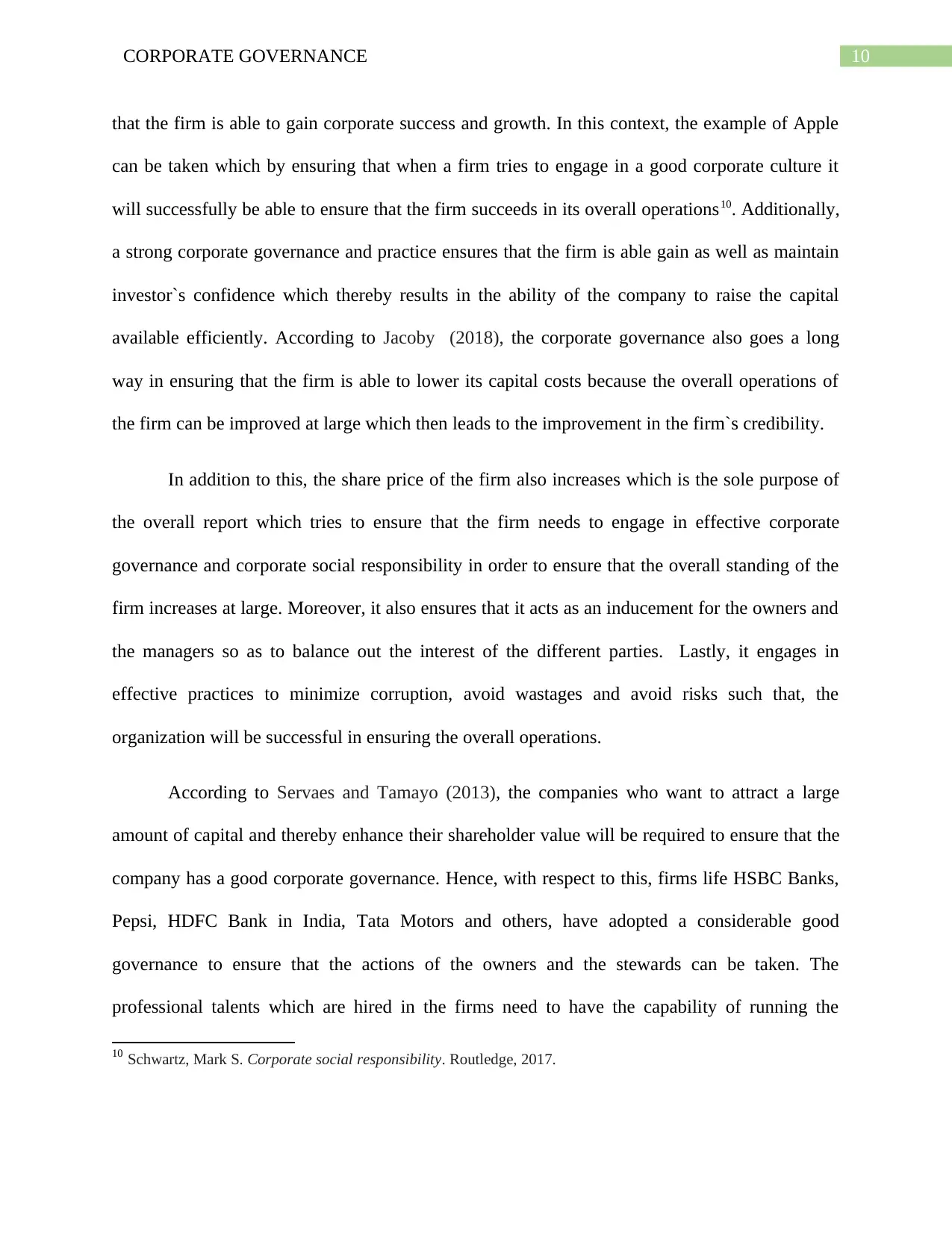
10CORPORATE GOVERNANCE
that the firm is able to gain corporate success and growth. In this context, the example of Apple
can be taken which by ensuring that when a firm tries to engage in a good corporate culture it
will successfully be able to ensure that the firm succeeds in its overall operations10. Additionally,
a strong corporate governance and practice ensures that the firm is able gain as well as maintain
investor`s confidence which thereby results in the ability of the company to raise the capital
available efficiently. According to Jacoby (2018), the corporate governance also goes a long
way in ensuring that the firm is able to lower its capital costs because the overall operations of
the firm can be improved at large which then leads to the improvement in the firm`s credibility.
In addition to this, the share price of the firm also increases which is the sole purpose of
the overall report which tries to ensure that the firm needs to engage in effective corporate
governance and corporate social responsibility in order to ensure that the overall standing of the
firm increases at large. Moreover, it also ensures that it acts as an inducement for the owners and
the managers so as to balance out the interest of the different parties. Lastly, it engages in
effective practices to minimize corruption, avoid wastages and avoid risks such that, the
organization will be successful in ensuring the overall operations.
According to Servaes and Tamayo (2013), the companies who want to attract a large
amount of capital and thereby enhance their shareholder value will be required to ensure that the
company has a good corporate governance. Hence, with respect to this, firms life HSBC Banks,
Pepsi, HDFC Bank in India, Tata Motors and others, have adopted a considerable good
governance to ensure that the actions of the owners and the stewards can be taken. The
professional talents which are hired in the firms need to have the capability of running the
10 Schwartz, Mark S. Corporate social responsibility. Routledge, 2017.
that the firm is able to gain corporate success and growth. In this context, the example of Apple
can be taken which by ensuring that when a firm tries to engage in a good corporate culture it
will successfully be able to ensure that the firm succeeds in its overall operations10. Additionally,
a strong corporate governance and practice ensures that the firm is able gain as well as maintain
investor`s confidence which thereby results in the ability of the company to raise the capital
available efficiently. According to Jacoby (2018), the corporate governance also goes a long
way in ensuring that the firm is able to lower its capital costs because the overall operations of
the firm can be improved at large which then leads to the improvement in the firm`s credibility.
In addition to this, the share price of the firm also increases which is the sole purpose of
the overall report which tries to ensure that the firm needs to engage in effective corporate
governance and corporate social responsibility in order to ensure that the overall standing of the
firm increases at large. Moreover, it also ensures that it acts as an inducement for the owners and
the managers so as to balance out the interest of the different parties. Lastly, it engages in
effective practices to minimize corruption, avoid wastages and avoid risks such that, the
organization will be successful in ensuring the overall operations.
According to Servaes and Tamayo (2013), the companies who want to attract a large
amount of capital and thereby enhance their shareholder value will be required to ensure that the
company has a good corporate governance. Hence, with respect to this, firms life HSBC Banks,
Pepsi, HDFC Bank in India, Tata Motors and others, have adopted a considerable good
governance to ensure that the actions of the owners and the stewards can be taken. The
professional talents which are hired in the firms need to have the capability of running the
10 Schwartz, Mark S. Corporate social responsibility. Routledge, 2017.
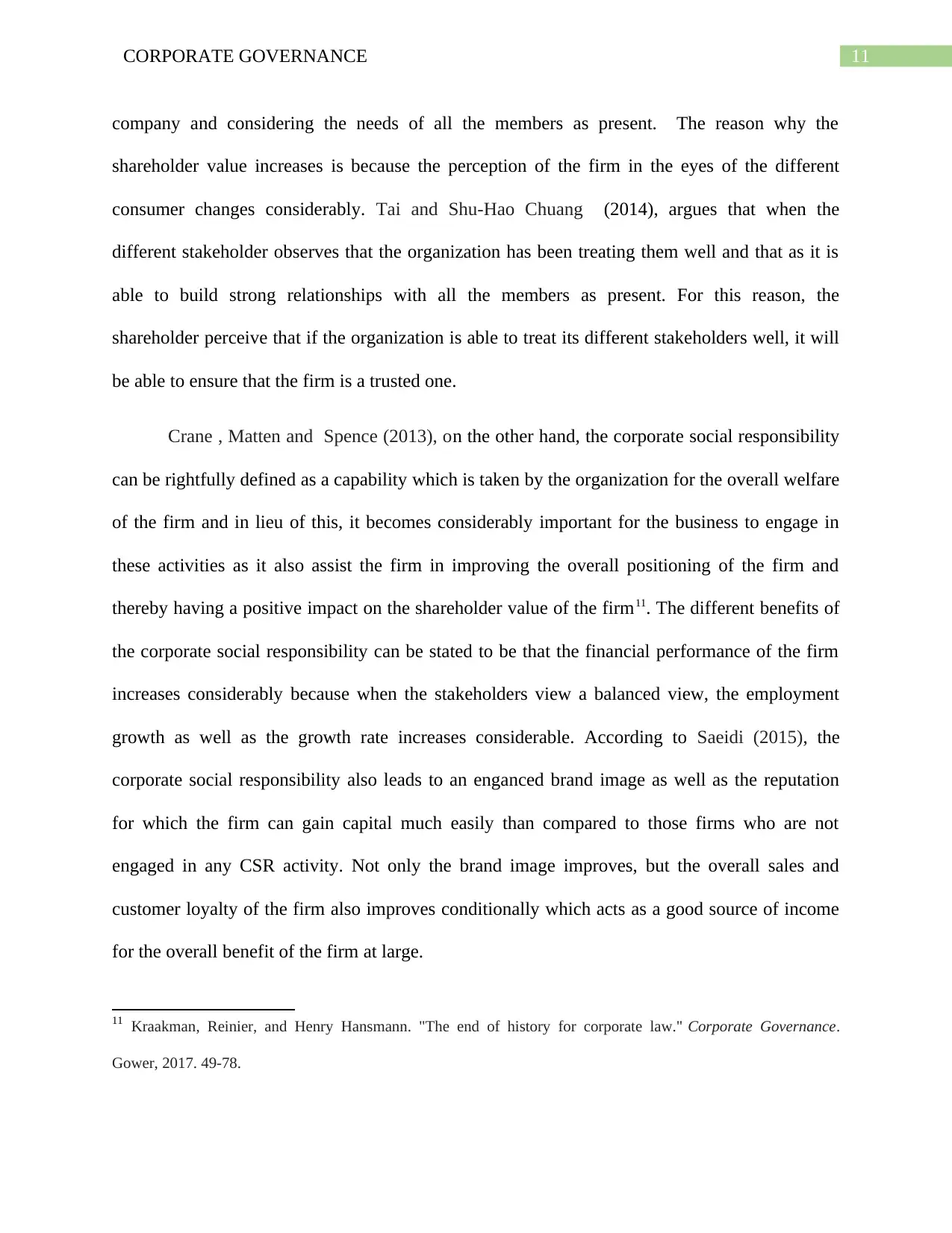
11CORPORATE GOVERNANCE
company and considering the needs of all the members as present. The reason why the
shareholder value increases is because the perception of the firm in the eyes of the different
consumer changes considerably. Tai and Shu-Hao Chuang (2014), argues that when the
different stakeholder observes that the organization has been treating them well and that as it is
able to build strong relationships with all the members as present. For this reason, the
shareholder perceive that if the organization is able to treat its different stakeholders well, it will
be able to ensure that the firm is a trusted one.
Crane , Matten and Spence (2013), on the other hand, the corporate social responsibility
can be rightfully defined as a capability which is taken by the organization for the overall welfare
of the firm and in lieu of this, it becomes considerably important for the business to engage in
these activities as it also assist the firm in improving the overall positioning of the firm and
thereby having a positive impact on the shareholder value of the firm11. The different benefits of
the corporate social responsibility can be stated to be that the financial performance of the firm
increases considerably because when the stakeholders view a balanced view, the employment
growth as well as the growth rate increases considerable. According to Saeidi (2015), the
corporate social responsibility also leads to an enganced brand image as well as the reputation
for which the firm can gain capital much easily than compared to those firms who are not
engaged in any CSR activity. Not only the brand image improves, but the overall sales and
customer loyalty of the firm also improves conditionally which acts as a good source of income
for the overall benefit of the firm at large.
11 Kraakman, Reinier, and Henry Hansmann. "The end of history for corporate law." Corporate Governance.
Gower, 2017. 49-78.
company and considering the needs of all the members as present. The reason why the
shareholder value increases is because the perception of the firm in the eyes of the different
consumer changes considerably. Tai and Shu-Hao Chuang (2014), argues that when the
different stakeholder observes that the organization has been treating them well and that as it is
able to build strong relationships with all the members as present. For this reason, the
shareholder perceive that if the organization is able to treat its different stakeholders well, it will
be able to ensure that the firm is a trusted one.
Crane , Matten and Spence (2013), on the other hand, the corporate social responsibility
can be rightfully defined as a capability which is taken by the organization for the overall welfare
of the firm and in lieu of this, it becomes considerably important for the business to engage in
these activities as it also assist the firm in improving the overall positioning of the firm and
thereby having a positive impact on the shareholder value of the firm11. The different benefits of
the corporate social responsibility can be stated to be that the financial performance of the firm
increases considerably because when the stakeholders view a balanced view, the employment
growth as well as the growth rate increases considerable. According to Saeidi (2015), the
corporate social responsibility also leads to an enganced brand image as well as the reputation
for which the firm can gain capital much easily than compared to those firms who are not
engaged in any CSR activity. Not only the brand image improves, but the overall sales and
customer loyalty of the firm also improves conditionally which acts as a good source of income
for the overall benefit of the firm at large.
11 Kraakman, Reinier, and Henry Hansmann. "The end of history for corporate law." Corporate Governance.
Gower, 2017. 49-78.
⊘ This is a preview!⊘
Do you want full access?
Subscribe today to unlock all pages.

Trusted by 1+ million students worldwide
1 out of 18
Related Documents
Your All-in-One AI-Powered Toolkit for Academic Success.
+13062052269
info@desklib.com
Available 24*7 on WhatsApp / Email
![[object Object]](/_next/static/media/star-bottom.7253800d.svg)
Unlock your academic potential
Copyright © 2020–2025 A2Z Services. All Rights Reserved. Developed and managed by ZUCOL.





